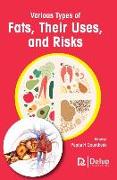Various Types of Fats, Their Uses, and Risks
BücherAngebote / Angebote:
Fat is essential for several body functions. Fat is an important part of the diet of humans and many other animals. It is an energy and protects the skeleton and nerves. Fats also make it possible for other nutrients to do their jobs. The body stores fat for protection, warmth, and energy. Not all fats are equally beneficial. Dietary fats are a significant part of our everyday diet, providing around 20-35% of our day-to-day energy needs. Apart from energy, they are fundamental for various biological functions such as growth and development. A small amount of fat is an essential part of a healthy, balanced diet. Fat is a source of essential fatty acids, which the body cannot make itself. This volume examines what dietary fats consist of, their location, sub-atomic structure, molecular, properties, and how to develop taste, texture, and food appearance. The volume likewise discusses the elements of fats in the body and examines the use of dry fats impact on human health. Fats help the body absorb vitamin A, vitamin D and Vitamin E. These vitamins are fat soluble which means they can only be absorbed with the help of fats. Any fat that's not used by your body cells of turned into energy is converted into body fat, likewise unused carbohydrates and proteins are also converted into body fat. Lipids are a wide range of n existing particles that consist of fats, sterols, waxes, and, fat-solvent vitamins A, D, E, and K, phospholipids, diglycerides, and monoglycerides, among others. Lipids consist of structural units with high hydrophobicity. This relevancy characteristic, instead of a typical structural component, monoglycerides this group of compounds. They mix with solvents but repel water. Fats and oils can be derived from animal sources (tallow, milk fat, lard), vegetables (vegetable oils, cocoa butter), and marine (cod liver oil, whale oil). They play a significant part in nutrition and physiological roles as they are a decent energy source (9 kcal/g) and contain essential soluble fats and fat-soluble vitamins in nature (comprising of hydrophobic and hydrophilic classes) with surface-active elements. In general, fats improve the nutritional capacity and add feel and texture. All types are high in energy. A gram of fat whether it is saturated or unsaturated provides 9 kcal (37 KJ) of energy compared with 4 kcal (17KJ) for carbohydrates and proteins. This book discusses food-technology processes and issues related to food reformulation. This book will be helpful for the students, researchers, clinicians, nutritionists and dieticians and professionals working on dietary supplements and food technology.
Folgt in ca. 15 Arbeitstagen

